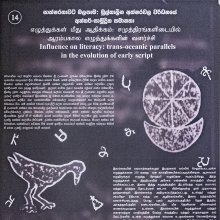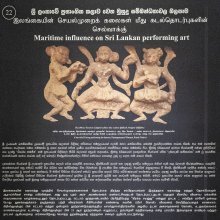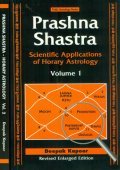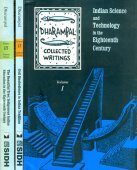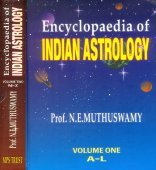Communication, Communicate, Communicated, Communicating: 3 definitions
Introduction:
Communication means something in Hinduism, Sanskrit. If you want to know the exact meaning, history, etymology or English translation of this term then check out the descriptions on this page. Add your comment or reference to a book if you want to contribute to this summary article.
Images (photo gallery)
In Hinduism
Purana and Itihasa (epic history)
Source: Shodhganga: Elements of Art and Architecture in the Trtiyakhanda of the VisnudharmottarapuranaCommunication (with foreigners) was commonly practiced, as part of the “sixty four kinds of Art”, according to the Kamasutra of Vatsyayana.—Cf the Sanskrit Mlecchitavikalpa, which refers to the “art of speaking of a new language, though indistinctly, as an option of communication”.—Indian tradition, basically includes sixty four Art forms are acknowledged. The history of Indian Art covers approximately five thousand years which presents a rich and almost continuous record. The references of sixty four kinds of Kala (कला, kalā) are found in the Bhagavatapurana, Shaiva-Tantras, Kamasutra of Vatsyayana etc.

The Purana (पुराण, purāṇas) refers to Sanskrit literature preserving ancient India’s vast cultural history, including historical legends, religious ceremonies, various arts and sciences. The eighteen mahapuranas total over 400,000 shlokas (metrical couplets) and date to at least several centuries BCE.
Vastushastra (architecture)
Source: Shodhganga: Elements of Art and Architecture in the Trtiyakhanda of the Visnudharmottarapurana (vastu)Communication with God (through prayers and chanting mantras) was lost in the Kali-yuga, according to Puranic lore such as the Viṣṇudharmottarapurāṇa, an ancient Sanskrit text which (being encyclopedic in nature) deals with a variety of cultural topics such as arts, architecture, music, grammar and astronomy.—In the Bhāgavatapurāṇa, it is said that after Dvāparayuga, on the very day when lord Kṛṣṇa left the earth, Kali, who is the source of irreligiousness had entered in this world. Thus, people of Kaliyuga have lost their power to communicate with God directly through prayers and chanting mantras. And that is why, specially in the Kali-yuga, the necessity of the temple building is suggested in the Viṣṇudharmottarapurāṇa.

Vastushastra (वास्तुशास्त्र, vāstuśāstra) refers to the ancient Indian science (shastra) of architecture (vastu), dealing with topics such architecture, sculpture, town-building, fort building and various other constructions. Vastu also deals with the philosophy of the architectural relation with the cosmic universe.
Yoga (school of philosophy)
Source: ORA: Amanaska (king of all yogas): A Critical Edition and Annotated Translation by Jason BirchCommunicating (parts of self-realization) is denoted by the Sanskrit term Sūri, according to the Amanaska Yoga treatise dealing with meditation, absorption, yogic powers and liberation.—Accordingly, as Īśvara says to Vāmadeva: “[...] Learned scholars who possess intellect do talk about the highest Brahma, [but] those who are skilled in communicating (ālāpa) [even] a small part of self-realization are hard to find in this world. [...]”.

Yoga is originally considered a branch of Hindu philosophy (astika), but both ancient and modern Yoga combine the physical, mental and spiritual. Yoga teaches various physical techniques also known as āsanas (postures), used for various purposes (eg., meditation, contemplation, relaxation).
See also (Relevant definitions)
Query error!
Full-text (+921): Nivedaka, Vacika, Sucita, Gudhabhashita, Upadesha, Nivedya, Samcara, Sanchar, Samvadana, Vijnapana, Janantika, Nivedita, Vishvasa, Pradeya, Avedita, Yogadana, Upadhana, Sampreshan, Sampreshana, Nivedana.
Relevant text
Search found 338 books and stories containing Communication, Communicate, Communicated, Communicating; (plurals include: Communications, Communicates, Communicateds, Communicatings). You can also click to the full overview containing English textual excerpts. Below are direct links for the most relevant articles:
The Malaysian Journal of Medical Sciences
Bilateral Anomalous Communication: Inferior Alveolar and Auriculotemporal Nerves < [Volume 21 (issue 5), Sep-Oct 2014]
Beyond Medical School - Time to Re-Look? < [v.7(2): 1–68 2000 Jul]
Communication in Medical Practice - Surfeit or Dearth < [v.6(2): 1–31 1999 Jul]
Gati in Theory and Practice (by Dr. Sujatha Mohan)
Analysis of technical terms: Abhinaya < [Chapter 1 - Nāṭya]
Nṛtta as a division of Āṅgika-abhinaya < [Chapter 1 - Nāṭya]
Analysis of technical terms: Nāṭya, Nṛtta, Nṛtya < [Chapter 1 - Nāṭya]
Vipassana Dipani (by Mahathera Ledi Sayadaw)
On Some Characteristics of Language < [July – September, 1981]
The Nature of Human Language < [July – September 1976]
The Nature of Human Language < [October - December 1976]
Vakyapadiya (study of the concept of Sentence) (by Sarath P. Nath)
5. The Concept of Sentence < [Chapter 1 - The Philosophy of Language: A Bhartṛharian Perspective]
1. Language Analysis in Vākyapadīya < [Chapter 3 - The Concept of Sentence and Sentence-Meaning]
World Journal of Pharmaceutical Research
An interconnection between median nerve and musculocutaneous nerve < [2018: Volume 7, November issue 18]
In vivo networking (ivn) < [2020: Volume 9, August special issue 9]
A review on role of regulatory affairs in pharmaceutical industry < [2022: Volume 11, February issue 2]
Related products
